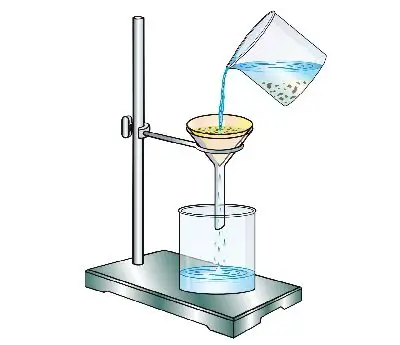
Filtration is the process of separating solid particles from a liquid using a porous material called a filter. The technique consists of pouring the solid-liquid mixture to be treated over a filter that allows the passage of the liquid, but retains the solid particles.
Water purification can be carried out by several methods, among which we can mention: Activated carbon filters, iodine, colloidal silver, chlorine, ultraviolet rays and even reverse osmosis.
How is the water filtered?
Ultrafiltration is generally considered to be that obtained with membranes whose pores allow the separation of molecules with a molecular weight greater than 10³ Dalton/gmol. With these membranes it is possible to separate and concentrate proteins, disinfect water by retaining bacteria and viruses, etc.
What water can be filtered?
Groundwater is naturally filtered through layers of soil, stone, gravel and sand. When water passes through these layers, they are cleaned. This is one of the reasons why many people think that groundwater is very clean.
Where does the filtering take place?
The glomerulus filters water and other substances from the bloodstream. Each kidney contains over 1 million tiny structures called nephrons. Each nephron has a glomerulus, the site of blood filtration.
What is food filtration?
Pre-filtration, clarification, stabilization and sterilization are key processes to protect the quality of the final product. Particles, yeast, mold spores and bacteria are removed in these filtration stages to ensure clear, clean beverages and prevent downstream blockages.
What benefits does water filtration bring?
By filtering the water we eliminate bacteria and reduce the risk of suffering any gastrointestinal disorder. In addition, we eliminate viruses and parasites without the need to use chlorine, as in some cases it can also be harmful to our health.
How is filtering used in everyday life?
Some everyday examples of filtering could be: Preparing the coffee. To make coffee or other infusions, the substance (tea, coffee, etc.) is placed in contact with boiling or very hot water, to force it to release its contents into the water.
How does the water come out when it passes through the filter?
The paper filter has holes (pores) that retain all those substances that are larger than the pore size of the paper, so the soil is retained in the filter while the water is collected in the boat.
What kind of mixture is filtering?
Filtration is a procedure used to separate heterogeneous solid-liquid mixtures where the solid is insoluble in the liquid. E.g. sand and water. Filtration is used to separate solid particles from liquid particles.
What is a household water filter?
Domestic filters reproduce the natural process that occurs in springs, where the water comes out clean thanks to the mechanical action of some substances present in the soil.
Where are the most common filters used?
It is used in industrial sectors such as food and beverage, pharmaceutical, chemical, environmental control, water treatment, academic and research.
How to reduce heavy metals in water?
The most efficient solution for its reduction are filtration systems for the absorption of heavy metals. This equipment is designed with a specific filtering medium that is responsible for eliminating this type of metal dissolved in water through contact with it.
What method is used to separate water from salt?
Reverse Osmosis This form of desalination is the transformation of a salty substance into a purified one. In this process, the water is separated from the salt by pressing the liquid. The pressure depends on the amount of solids and the desired degree of desalination.
How is decanting used?
Decantation is used to separate heterogeneous mixtures, which may consist of a liquid and a solid substance, or two liquid substances of different densities.